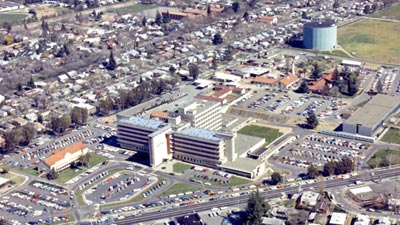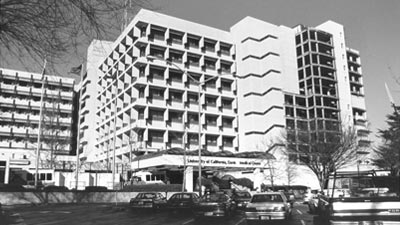New drugs, big neighbors and more change
In 1908, the California State Fair had moved from various spots around the Capitol to become a next-door neighbor of the Sacramento County Hospital, with the fairgrounds growing to more than 200 acres in the 1930s. By 1938, it was the largest state fair in America, and into the 1950s, it was called one of the country’s top attractions. The fair paused from 1942-47, when the grounds were used for military purposes.
In the 1950s and ’60s, the fair drew national class performers to the grounds and its concert venue, Governor’s Hall. The ’50s stars included Duke Ellington, Bob Hope, Bing Crosby, Peggy Lee and Lawrence Welk. In the 1960s, Governor’s Hall hosted rock bands ranging from The Grateful Dead, Country Joe and the Fish, Buffalo Springfield, Quicksilver Messenger Service and the Yardbirds to lesser known acts including The Chocolate Watchband and the Davis-based band Andrew Staples. (Governor’s Hall, which later served as the Sacramento County Primary Care Center into the turn of the 21st century until 2003, is still on the UC Davis Health campus. It’s scheduled for demolition in 2021).
But by the late 1960s, the now-urban fair site became an increasing burden on the growing neighborhoods around it. The State Fair moved to Cal Expo in 1968 and nearly half of the old grounds would eventually become part of the Sacramento campus of UC Davis, home of UC Davis Health and the growing UC Davis Medical Center.
For the Sacramento County Hospital, World War II meant continued work on site but an interruption for some of its health care staff. A number of doctors from the region, including some from the county hospital, sponsored, organized and staffed the 51st Evacuation Hospital, which would support U.S. troops in Italy and France in 1944, then move into Germany in 1945. Among its duties there, the unit treated freed prisoners of war. It was thanked by the War Department for its service, skill and valor.
Back in Sacramento in April 1945, just before V-E Day and the end of the war in Europe, Sacramento County Hospital superintendent Dr. Leo Farrell introduced the “wonder drug” penicillin to the Sacramento region just one month after it became available for public use.
In the 1940s, the Sacramento County Hospital was designated as the polio center for inland Northern California, housing patients in its Isolation Ward 21. Even with a century of improvements, the hospital in the 1940s was susceptible to floods of a sort. The basement would flood in the wettest winter months and nurses wearing hip boots would retrieve patients from the lowest level. The problem was finally fixed with improved drainage.



